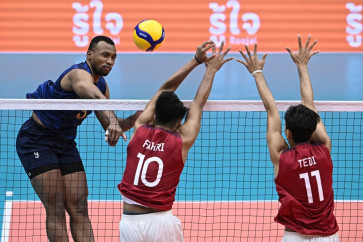Popular Reads
Top Results
Can't find what you're looking for?
View all search resultsPopular Reads
Top Results
Can't find what you're looking for?
View all search resultsJAVA'S HEALTH SYSTEM PARALYZED
Patients forced into self-treatment as hospitals near capacity, many die without getting help
Change text size
Gift Premium Articles
to Anyone
I
ndonesia is facing its darkest pandemic days ahead as local hospitals grapple with soaring cases amid shortages of ICUs and oxygen tanks.
The country posted record highs of 555 deaths and 27,233 new cases on Sunday, with Jakarta contributing over 10,000 new cases, West Java almost 4,500 and Central Java nearly 3,000. New emergency public activity restrictions (PPKM Darurat) have been in place across Java and Bali since Saturday to weather the unprecedented second wave of infections that is fueled by increased mobility around the Idul Fitri holidays and the emergence of the more contagious Delta variant.
Coordinating Maritime Affairs and Investment Minister Luhut Binsar Pandjaitan predicted daily confirmed cases would continue to increase in the next two weeks, saying as quoted by kompas.com on Saturday that “This is our critical period for the next two weeks.”
Luhut, in a press briefing on Sunday, promised to move quickly to provide more hospital beds, health equipment and oxygen for COVID-19 patients, including preparing a makeshift hospital at the haj dormitory in Pondok Gede, East Jakarta to accept 600 to 700 patients.
Read also: Indonesia expects COVID-19 cases to rise despite stricter curbs
This came after the LaporCOVID-19 community reported at least 265 people died of COVID-19 in home isolation or waiting to receive emergency care at the hospital throughout last month until July 2. The victims were spread across 10 provinces, with all six Java provinces reporting the highest number of victims.
The group noted that its report did not represent the actual conditions since a high number of cases was underreported, saying: “We are worried that this is the tip of the iceberg and must be anticipated immediately to prevent more people from dying outside of health facilities”.
The LaporCOVID-19 report appears to relate to the Health Ministry report on bed occupancy, which shows that all six provinces in Java where PPKM Darurat are in place are running out of beds for COVID-19 patients. Jakarta, Banten, West Java and Yogyakarta reported 90 percent bed occupancy rates and above on Saturday, followed by Central Java with 87 percent and East Java with 80 percent.
“This is a real portrait of the health facility collapse which has made it difficult for COVID-19 patients to get proper medical services. This situation is exacerbated by poor communication, which causes some people to avoid going to the hospital and prefer to self isolate,” the group said.
Governor Anies Baswedan said in a televised statement that the hospital availability data did not reflect reality, since people in Jakarta were having a hard time finding COVID-19 beds or ICU beds, predicting that active cases could reach 100,000 this week. Currently, active cases in Jakarta stand at around 86,000.
As many as 40 confirmed COVID-19 deaths were recorded across the capital on Saturday, on the same day as 392 people were buried under COVID-19 protocols, which, according to Anies, was 10 times higher than 25 burials on May 1.
Read also: Hospitals ‘collapse’ as second wave engulfs Indonesia
Health Ministry spokesperson Siti Nadia Tarmizi was not immediately available for comment. But in a report by Kompas TV, she denied that health facilities in Indonesia had collapsed and that patients died during self-isolation due to delayed treatment. "It's better to go to the hospital immediately, don't wait at home," she said.
According to Nadia, there were still many hospitals available and even expanded rooms for COVID-19 patients. For instance, in Jakarta, private hospitals provide additional rooms for these patients.
Oxygen shortage as patients gasp for air
Panic struck Muhammadiyah Hospital in Gombong, Central Java on Saturday. All elective surgeries were put on hold, even canceled, as nurses scrambled to check the patients who were considered in critical need of oxygen.
On Sunday, the hospital will have depleted its oxygen reserves. Over two dozen patients who were on ventilator machines will be left to breathe on their own. Some were in critical condition.
“We are shaking,” Ibnu Naser Arrohimi from hospital management told The Jakarta Post on Saturday. “We are trying our best to buy time until the oxygen arrives.”
In the neighboring regency Sleman, Dr. Sardjito Hospital ran out of oxygen on Saturday. In a letter to the health minister, Sardjito president director Rukmono Siswishanto has pleaded for the government’s support as the hospital can only get new supplies to arrive by 12 p.m on Sunday at the earliest.
“This will risk the safety of both COVID-19 patients and non-COVID-19 patients,” the letter said.
Read also: Indonesia’s static positivity rate highlights persisting gaps in testing capacity, capability
In recent weeks, the Indonesian Hospital Association (PERSI) has received complaints from hospitals not having enough medical oxygen.
“We need the government's guarantee that the distribution of medical oxygen can reach hospitals as needed and in time,” association secretary-general Lia Gardenia Partakusuma said.
She said most hospitals were equipped with a bulk medical oxygen delivery system where liquid oxygen is converted into oxygen gas and channeled through connection ports located in wall panels in a hospital room.
But many hospitals across Java had to set up emergency tents to cater to a deluge of patients, forcing them to switch from using liquid oxygen to buying more portable oxygen canisters to cope with demand, causing a shortage in some parts of the country.
Families of the sick are filling social media with pleas for oxygen. Others are turning to relatives, friends, co-workers, public figures -- anyone who might have a lead on a cylinder.
Some even say they have paid at least thrice the usual price, and media reports showed that people were lining up with empty oxygen tanks to refill for their sick loved ones.
Read also: Emergency mobility restrictions now in full effect
Last week, when her father started complaining of breathlessness after testing positive for the virus, Andini Julianti, 26, tried to get him to hospitals in Jakarta, only to be turned away and told to get an oxygen tank for her father who should isolate at home.
But oxygen tanks at the time were nowhere to be found, she said, either around Jakarta or on online marketplaces.
“I thought to myself while I was out there, how could I come home without one?” Andini told the Post on Friday.
She finally borrowed one from a friend, but her father's condition did not get any better. She eventually managed to get him into Jagakarsa Regional General Hospital the next day.
Unmet demand
Despite the apparent shortage in parts of the country, Industry Minister Agus Gumiwang Kartasasmita has said the country has enough oxygen supply to meet medical needs, with a supply capacity of 850 tons per day, compared with daily oxygen demand of around 800 tons for COVID-19 care.
“The situation we are seeing is a result of the slow rotation of oxygen cylinders due to the spike in COVID-19 cases,” Agus said in a statement on Tuesday.
Agus said he had increased the allocation of oxygen production for medical purposes to 60 percent, from initially 40 percent. Later last week, Luhut asked Agus to direct 90 percent of its production to the healthcare system.
Ibnu disagreed, saying the distribution and mobility of medical oxygen was not the sole problem.
“No matter how large the oxygen supply is, if all those who come [to the hospital] are experiencing severe desaturation, there will definitely be disturbances,” said Ibnu, adding that many patients came to the hospital already with low oxygen saturation of 60 to 70 percent. Patents in such a condition usually need a ventilator.
Ibnu added that his hospital had not received any payment for COVID-19 treatment from the government since last October. “We even couldn’t afford to buy ventilators, even though they are badly needed.”










